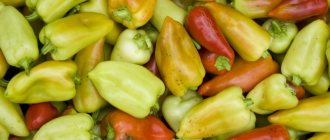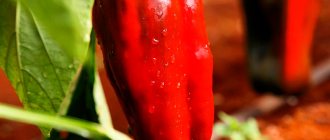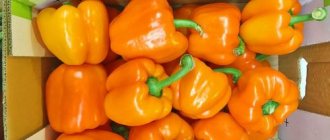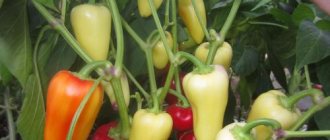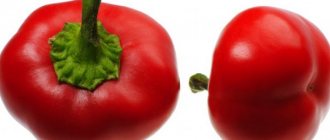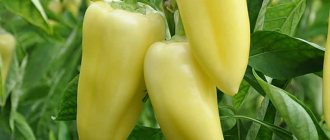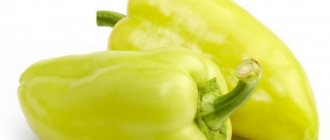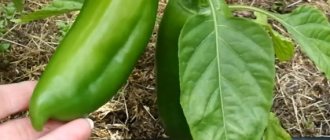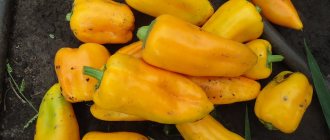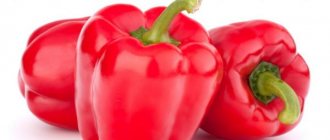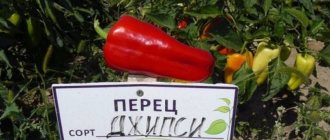Advantages and disadvantages
Farmers plant Khalif F1 pepper in plots because its advantages include the following:
- The culture is not susceptible to tobacco mosaic virus.
- The fruits can be stored for 2 - 3 months after collection.
- Plants are not afraid of hot weather and can produce crops during short periods of cold weather.
- Pepper is transported without loss of quality.
- The fruits are suitable for many culinary ideas.
- The bushes are low and do not require special shaping or staking.
- With good care, the hybrid has a yield of more than 7 kg/m2.
Among the disadvantages, farmers note the inability to grow peppers from their own seeds. To obtain a harvest, the gardener needs to purchase planting material annually.
Typical diseases and pests
Khalif pepper has increased resistance to tobacco mosaic disease, but can be affected by:
- gray and white rot;
- downy mildew;
- late blight;
- black leg.
It is much more effective to carry out prevention, which consists of treating the bushes with a 0.05% solution of potassium permanganate, a 4% solution of copper oxychloride or Bordeaux mixture.
Of the harmful insects, pepper is most often attacked by aphids, spider mites, slugs, Colorado potato beetles, etc. They are combated with the help of insecticidal preparations.
In order for Khalif pepper to maximize all the positive qualities inherent in the variety, it is important to follow agricultural practices. A crop grown in compliance with all necessary conditions will have good immunity and will not become a victim of disease or pest attack.
Among the diseases to which the vegetable is exposed are gray and white rot, downy mildew, late blight, black leg, etc. Khalif has increased immunity to a disease characteristic of peppers, such as tobacco mosaic.
It is much easier to take preventive measures that will prevent the occurrence of a disease than to cure an already infected crop. As a preventive measure against diseases, the following treatments are carried out:
- 0.05% potassium permanganate solution;
- "Previkur";
- 4% copper oxychloride solution;
- Bordeaux mixture;
- charcoal, etc.
Among the pests that can negatively affect the yield of pepper are aphids, spider mites, slugs, Colorado potato beetles, etc. They are regularly treated with special fungicides, combining them with traditional methods (infusions of garlic, onion, dandelion, celandine, etc.).
Despite the hybrid’s resistance to fungi and infections, it can get sick if not cared for properly.
The most dangerous diseases:
- Brown spot (cladosporiosis). Occurs due to contaminated soil, non-compliance with crop rotation rules, heat and high humidity. The stems and leaves become covered with brown spots, which increase in size over time. Spraying with whey is used as a preventive measure; for treatment, the professional drug “Zaslon” is used. Apply the product strictly in accordance with the dosage on the package.
- Black bacterial spot affects mature plants during the fruiting period. For prevention, use a soap solution or copper sulfate. If bacterial spotting appears, the affected bushes are removed from the garden bed and burned away from the area. The remaining plants are treated with a solution of potassium permanganate.
The Colorado potato beetle is a pest. The striped insect affects both young seedlings and adult bushes. Larvae and adults are dangerous. The Colorado potato beetle is able to live underground for up to two years and tolerates cold and low temperatures. It feeds on plant sap, which is why the pepper lacks vitamins for development. The drugs “Barrier” or “Tornado” help to cope with the pest.
Outdoor care
- You need to moisten the soil regularly, but avoid overwatering. Excess moisture can contribute to the development of fungal diseases. You need to water the Khalif pepper in the morning or evening with warm, settled water.
- It is necessary to carry out loosening and weeding. This will improve the air permeability of the soil and retain moisture in it longer.
- During the season, peppers are fertilized at least 3-4 times. The first is in the phase of two true leaves. The fertilizer should consist of a mixture of superphosphate, nitrate and potassium. After a couple of weeks, a second feeding is carried out with the same composition, but doubling the dose of nutrients. The third and subsequent feedings are carried out during the formation of the ovaries. Potassium-phosphorus fertilizers will have a positive effect on the formation of fruits.
- During the growth process, Khalif pepper requires shaping, which involves removing side shoots and leaves before the first fork. It is also necessary to organize a support to which the shoots of the bush will be tied in order to prevent deformation and breakage of the branches due to the weight of the fruit.
- In order for repeated harvests to ripen faster, it is recommended to remove the top of the bush after half the fruiting period.
Tips for growing, features of agricultural technology
You can sow Stanley for seedlings at the end of winter. Plant the sprouts in separate containers after the formation of 2 true leaves. After transferring the plants to the garden soil, consider the location of stakes for support and immediately install them. For 1 sq. m plot will fit 4-5 varietal bushes.
Advice. Harvest the crop as it ripens. This way you will prolong fruiting and achieve better productivity.
Sowing seeds for seedlings | Planting seedlings in a greenhouse/greenhouse | Planting seedlings in exhaust gas | Stepsoning | Harvesting (in the greenhouse/in the greenhouse) |
| Mid-February – early March | The end of May | The beginning of June | Removing lateral shoots and leaves up to the 1st fork | End of July/beginning of August |
| *dates are indicated for central Russia |
Description and characteristics of pepper variety Goliath, reviews, photos
Mid-season, large-fruited variety of bell pepper from Siberian breeders. Recommended for cultivation in open ground, film shelters, and greenhouses.
The bush is semi-spreading, 60-70 cm high. The plant needs to be tied to a support and formed.
The leaf of this pepper is medium-sized, dark green, wrinkled.
Goliath sweet pepper was included in the State List in 20015. register for the Russian Federation for cultivation in open ground and under film covers on private farms.
Basic qualities of fruits
The fruits are large, prism-shaped, green at the stage of technical ripeness, deep red at the biological stage, weighing 250-400 grams, juicy, excellent taste without bitterness. The wall thickness is up to 1 cm. This pepper is recommended for fresh use and various types of home cooking.
Description of the variety
general characteristics
Early ripening hybrid. From the moment the first shoots appear until the start of ripening, 90-95 days pass. The plant is a compact medium-leafed bush, reaching a height of 60-90 cm.
Advantages and disadvantages
Advantages:
- Successfully forms ovaries even in unfavorable growing conditions.
- Characterized by long-term fruiting.
- High-yielding.
- Has high resistance to tobacco mosaic virus.
Flaws:
- The need to tie the bush to a support so that the branches do not sag under the weight of the fruit.
- Weak root system.
Description of appearance
The fruits of the Khalif F1 pepper have a cubic-prismatic shape. The walls of the pepper are strong, 7-9 mm thick, the flesh is dense. At the stage of technical ripeness, the fruit has a light green color, while at the biological stage it is milky, turning into red. On one plant you can find fruits ranging from milky white to deep red. The average weight of one pepper is 80-120 grams, size 9 by 10 cm.
Resistance to diseases and pests
Khalif pepper is resistant to the tobacco mosaic virus; preventive measures must be taken against other diseases. The crop is also able to resist attacks from harmful insects.
Chemical composition
Indicators are calculated per 100 g of product:
| Calories | 27kcal |
| Squirrels | 1.3g |
| Fats | 0.1 g |
| Carbohydrates | 5.3 g |
| Alimentary fiber | 1.9 g |
| Water | 92 g |
| A | 13,4% |
| b-car | 25,2% |
| IN 1 | 4,6% |
| AT 2 | 2,1% |
| Kholin | 0,9% |
| AT 5 | 0,6% |
| AT 6 | 6,9% |
| AT 9 | 3,5% |
| WITH | 65,2% |
| E | 8,2% |
| TO | 3,2% |
| RR | 6,9 |
Marketability
Khalifa can be classified as a variety with high marketability.
The excellent appearance of the vegetable is due to the density of the pulp and the glossy shine of the skin, as well as the fact that the color of ripe fruit effectively varies from milky to red.
Taste qualities
The fleshy, juicy pulp has excellent taste. There is no bitterness at all. The vegetable is excellent for both fresh consumption and for preparing various dishes and canned preparations.
Benefits and harms
Benefit:
- Prevents the formation of blood clots.
- Useful for pregnant women, as it promotes the healthy development of the fetus.
- Useful in the prevention of cancer.
- High content of vitamin C, enhanced with vitamin P. This combination has a hypoglycemic and antioxidant effect.
- Fiber in the composition neutralizes toxins.
Harm:
- Not recommended for use by people suffering from hypertension, central nervous system disorders, kidney and liver diseases.
- Peppers purchased from unverified sellers may contain large amounts of nitrogen compounds.
Comparison in the table with other varieties
| Caliph | Golden Taurus | Jaguar | Martin | Belozerka |
| 6-7 kg per sq.m. | 7-8 kg per sq.m. | 3-4 kg per sq.m. | 2-3 kg per sq.m. | 1.5-2 kg per sq.m. |
A Brief History of Breeding
The hybrid was bred by breeders of the Japanese company Sakata. Seeds are imported to Russia from the French branch of the famous company. The hybrid was included in the State Register in 2014.
Sweet pepper - varieties for the Urals
Many varieties of pepper are suitable for the Urals. In Bashkortostan, Kurgan region, Orenburg and Chelyabinsk regions you can grow:
- ROMANTSOV'S FIRST-BORN
- GOLDEN CALF
- FRESHNESS
- BEAR
- MARTIN
- SIBERIAN BONUS
- FATHER FROST
- SIBERIAN FORMAT
- GOLIATH
- EUROPEAN
- GOTHIC
- Rizhik
- COLD
- HONEY KING
- AN EARLY MIRACLE
- KUBOVICH
- OPENWORK
- ELEPHANT
- NUGGET OF THE EAST
- LUCK
- ISTRINKA
- PEKINGESE
- FIGHTER
- CANDLE
- SUCCESSFUL
- CHIP
- DMITRIY
- VYATICH
- CHAPAI
- ORANGE GOURMAR
- DOMINATOR
- MAGELLAN
- DELIGHT
- MARQUIS
- TACITUS
- SPARTA
- FLAVIUS
- PALERMO
- GLADIATOR AGRO
- TURQUOISE
- GOLDEN BARREL
- ZYATEK
- OCCUPATION NEW YEAR
- HANDSOME MAN OF PRIOBIE
- GARNET BRACELET
- VON BARON ORANGE
- GENEROSITY
- ZADOR
- GOLD AUTUMN
- KAKADU YELLOW
- RED NOSE
- GOLDEN CUP
- CUBANO
- RUBY CUP
- TEQUILA
- LOTTA
Pepper varieties for the Urals - description
Sweet pepper FIRST-BORN ROMANTSOVA
The variety is suitable for growing in open ground and under temporary film covers. Early ripening.
The period from full germination to the beginning of technical ripeness of the fruit is 80-112 days.
The plant is standard, semi-spreading, medium-leaved, 45-55 cm high.
The fruit is drooping, cone-shaped, glossy, yellowish in technical ripeness, red in biological ripeness. Number of nests 3-4. The thickness of the fetal wall is 3.5-4.2 mm (up to 7 mm). Fruit weight is 32-67 g (up to 90 g). The taste is good to excellent. The aroma is weak.
Variety FRESHNESS
The variety is suitable for growing in open ground and under film covers. Early ripening. The period from full germination to the beginning of technical ripeness of the fruit is 99-112 days.
The plant is semi-spreading, medium-leaved, 55-65 cm high.
The fruit is drooping, prism-shaped to cone-shaped, smooth, glossy, yellowish in technical ripeness, red in biological ripeness.
Number of nests 3-4. The thickness of the fetal wall is 4.0-4.5 mm. Fruit weight 32-68 g. Taste is good to excellent. The aroma is weak. The yield of marketable fruits in open ground is 0.8-1.8 kg/sq.m, maximum - up to 7 kg/sq.m. m (Krasnoyarsk region).
Sweet pepper variety GOLDEN CAURUS
The variety is suitable for growing in open ground and under film covers. Mid-season.
The plant is semi-spreading, of medium height.
The fruit is drooping, cube-shaped, highly glossy, dark green in technical ripeness, dark orange in biological ripeness.
Number of nests 3-4. Fruit weight is 104-173 g, wall thickness is 7-10 mm, the taste is good and excellent, the aroma is average.
Variety BEAR
Suitable for growing in open ground and under film covers. Medium early variety.
The plant is closed and tall.
The fruit is drooping, cylindrical, long, highly glossy, the color is green at technical ripeness, dark red at biological ripeness.
Number of nests 3-4. Fruit weight 128 g, wall thickness 9-10 mm. The taste of fresh fruit is excellent. The yield of marketable fruits under film covers is 3.0 kg/sq.m, in open ground - 1.8 kg/sq.m.
Santa Claus variety
Suitable for growing in open ground and under film covers. The variety is early ripening. The plant is semi-spreading, of medium height.
The fruit is drooping, cylindrical, highly glossy, the color in technical ripeness is dark green, in biological ripeness it is dark red.
Number of nests 3-4. Fruit weight 100-120 g, wall thickness 6-7 mm. The taste of fresh fruit is excellent. The yield of marketable fruits under film covers is 7.0-8.2 kg/sq.m.
Sweet pepper variety SIBERIAN BONUS
The variety is intended for cultivation in open ground and under film covers. The variety is mid-season.
The plant is spreading, of medium height.
The fruit is drooping, cube-shaped, green in technical ripeness, dark orange in biological ripeness. Number of nests 3-4. Fruit weight 100-110 g, wall thickness 6-8 mm. The yield of marketable fruits under film covers is 5.5-6.7 kg/sq.m.
Pepper variety SIBERIAN EXPRESS
Suitable for growing in open ground and under film covers. Early ripening.
The plant is semi-spreading, of medium height.
The fruit is drooping, trunk-shaped, glossy, the color in technical ripeness is greenish-white, in biological ripeness it is dark red.
Number of nests 2-3. Fruit weight 40 g, wall thickness 3-4 mm. The yield of marketable fruits in open ground is 1.5 kg/sq.m.
It is worth clarifying that over the past year, all sweet pepper varieties added to the state register are listed as universal and are recommended for cultivation in all regions without exception, including the Urals. Therefore, you can safely choose any modern variety you like. After all, growing methods in different regions are still different.
- Varieties of large peppers
- Sweet pepper - early varieties
- Yellow sweet pepper - varieties
- Sweet pepper - hybrids and description
- Sweet thick-walled pepper - varieties
- Red sweet pepper - varieties
Popular crops for open ground
“Open” peppers, by default, are more resilient than sissies from greenhouses, and are better able to withstand attacks from pathogens and pest attacks. As a result, the gardener should receive juicy, sweet fruits for a variety of uses - cutting, salads, canning.
Big mom
This species is rare for Russia. The variety with a bright orange color is a product of domestic selection. For pepper, the color is unusual and unusual, which does not affect the taste or technical characteristics of the fruit. According to laboratory studies, the color orange is strongly associated with sweetness because these vegetables contain beta carotene. Big Mama is good for health, recommended for heart disease, and for strengthening blood vessels. These peppers are also juicy and tasty; they are successfully used raw and canned.
Dandy
Medium-sized bushes bred in Western Siberia and adapted for harsh climates. Peppers are distinguished by their honey-yellow color and fruit shape (slightly swollen, reminiscent of a barrel). The vegetables are large, weighing up to 200 grams, with a wall thickness of 7 millimeters. Agronomists, in addition to endurance and unpretentiousness, have achieved decent commercial characteristics from Shchegol.
Martin
A species that develops not upward, but outward: bushes with a pronounced spreading form of growth. The height reaches 60 centimeters; the pepper needs additional support. According to its characteristics, the variety is of medium ripeness and reaches the technical level at 116-120 days. Swallow has a good yield: the square world of the plantation will yield up to 5 kilograms of sweet pepper.
The shape of the fruit is a classic, slightly inflated cone. The wall is from 5 to 7 millimeters, the color is bright red. The length of ripe specimens is up to 100 millimeters, weight is up to 100 grams. Positioned as an easy to grow variety.
Belozerka
A productive variety with an average harvest time. It would be more correct to call Belozerka a hybrid. The bush grows up to 70 centimeters in height, the fruits are first yellow, then gradually turn red. Resistant to pests and diseases, extremely tasty, with an emphasized sweet note and juicy pulp.
Golden medal
Excellent grown in field conditions, open ground. The height of the bush is up to 1 meter. The fruits are red in color, straight in configuration, up to 13 centimeters in length and weighing up to 50 grams. The wall is of moderate thickness, no more than 4 millimeters. The species is classified as early ripening.
Triton
Triton, with its compact bush size, grows bright red, sweet peppers. Unpretentious, ripens early. The weight of the fruit is up to 150 grams, the wall is medium. The pulp is juicy, suitable for salads and canning.
Description of the harvest
The seed from which Goliath peppers are grown is quite expensive. However, the cost pays off well, since as a result, vegetable growers harvest much more than from simple popular varieties. On average, up to 12 peppers can be removed from each bush.
Gardeners who grew this vegetable crop on their plots describe the resulting harvest as follows:
- The fruits have a cone shape, reach 6 centimeters in diameter and 14 centimeters in length.
- The weight of each pepper is 130-160 grams.
- The wall thickness is average - 7-8 millimeters, thanks to which vegetables can be stored frozen for quite a long time. In addition, the thickness of the walls allows fruits to be transported over long distances, without losing their marketable characteristics. The shelf life in nets is 14-21 days.
- At the stage of technical maturity, peppers are colored green. Having reached a state of biological ripeness, they acquire a bright red color with a whitish waxy coating.
- The plant bears fruit for a long time and consistently. When the fruits are picked before biological ripeness, they gradually turn red until the New Year holidays.
Transplanting seedlings
Sweet and tasty peppers in fertilized soil
Sweet peppers of the Khalif variety grow well in light, loose, well-fertilized soil. In the fall, organic and potassium-phosphorus fertilizers are first applied to it. In spring, it is advisable to enrich the soil with ammonium nitrate (30-40 g per 1 m2).
5-7 days before transplanting seedlings, it is recommended to disinfect the soil using a solution of copper sulfate (1 tablespoon per 10 liters of water).
Seedlings are transplanted into open ground when the soil has warmed up well and the risk of night cold snaps is minimal (late spring-early summer). For greenhouse cultivation, peppers can be planted in early April.
Planting scheme for young peppers Khalif f1: 3-4 bushes are placed per 1 m². It is necessary to place the seedling in the hole at the same depth at which it grew in the nursery, without exposing the root system and without hiding the root collar in the soil. Immediately after transplanting, it is advisable to water and attach the crop to a support installed nearby.
It is advisable to plant this vegetable after legumes, early cabbage, herbs or onions.
Proper care of peppers will give you the opportunity to get the maximum yield of quality vegetables. This ensures that the crop will have good immunity and be less susceptible to diseases and pest attacks typical of these vegetables.
Watering
Watering is carried out in the morning or evening with warm rain or settled water. It is advisable to alternate it with loosening and weeding. This will retain moisture in the soil for a longer time, and air access to the rhizome will improve. Some vegetable growers mulch the soil with straw.
Feeding
Peppers require constant care
It is recommended to fertilize pepper at least 3-4 times during the season. Systematic monitoring of the condition of plants will allow you to quickly determine what substance the soil lacks.
In the phase of appearance of 1-2 true leaves, the first feeding is carried out using the following solution: 2-3 g of superphosphate, 0.5 g of nitrate, 1-2 g of potassium are added to 1 liter of water. After 2 weeks, fertilizing is repeated, increasing the amount of mineral fertilizers up to 2 times.
Popular among gardeners are feeding peppers with nettle infusion and a solution of chicken manure (1:10). It is advisable to alternate them with mineral supplements (1 tablespoon of nitrophoska per 10 liters of water).
It is necessary to regularly apply potassium-phosphorus fertilizers to the soil, which affect the number of ovaries on the crop and the quality of vegetables.
Pruning and shaping the bush
The Khalif pepper bush is described as compact, but this does not relieve the gardener from the need for regular pinching (pruning) of the crop. Its essence is to remove side shoots, which accelerate their growth in wet weather. It is undesirable to carry out pinching in the heat: the presence of additional foliage on the bush protects the soil from rapid evaporation of moisture.
The lowest, longest shoots should be pruned; you should try to achieve maximum illumination of the bush with sunlight. It is also worth removing unnecessary branches of the culture. Stepping is carried out once every 7-10 days, more often if necessary.
The Khalif variety requires the formation of a bush and its subsequent tying. When the crop reaches a height of 20-25 cm, the top, which is located on the main stem, is removed. Of the remaining strong shoots, it is recommended to leave no more than 3-4 stepsons.
To speed up the ripening of vegetables, gardeners advise once again additionally removing the top of the bush plant after half the fruiting period.
The best varieties of bell pepper
This was three years ago. I went to the market and my gaze involuntarily stopped at the luxurious bell peppers - red, green, yellow. Beauty, I just want to take a bite! Seeing the price, I quietly stepped aside - I couldn’t afford it. I think that many of you have also found yourself in a similar situation. It became a shame. I decided to try to grow this “miracle” myself. The family is big and why not please my household members with delicious peppers too? Then some newspaper turned up and saw there an advertising module “Harvest Bed” agro. I heard about this company, a seed producer, from summer residents. The company offered customers more than 60 varieties and hybrids of sweet and hot peppers.
True, I am always cautious about advertising, but I took a risk and prescribed the seeds. I got the varieties - wonderfully!
Mirage is a highly productive and very early ripening variety. Plants are low-growing, compact, bouquet type. The fruits are blunt-conical and conical in shape, weighing 100-110 g, fleshy (wall thickness 7-8 mm). At different stages of ripening, the color of the fruit changes. The colors smoothly transition from white (ivory) to orange and then to red. Therefore, fruits at any stage are popular among market gardeners. Peppers of bright colors are always in demand among buyers. They also look beautiful on the table.
Zorka is an early variety that will delight you with the colors of the elements - from light straw, orange to bright scarlet. The fruits are juicy, the pulp is sweet. The bush is slightly larger than Mirage's and the peppers are larger.
Corvette is a classic variety of sweet pepper. The variety is early ripening, high-yielding, the fruits are small 60-80 g, conical. Awarded the Gold Medal of the Tsaritsyn Fair "Volgograd-2004". The pepper will delight you with light green fruits in technical ripeness and glossy bright red fruits in biological ripeness. The variety is exceptionally good for canning.
Player is a low-growing plant, very compact, a highly productive variety, and ripening early. Peppers are cuboid and tomato-shaped, weighing 130-150 g, with very thick walls 9-12 mm. Player - as it matures, it changes colors from green in the initial stage, and when fully matured it turns red. Imagine how you can diversify pickles using such characteristics of varieties!
The next year, other pepper hybrids appeared in my beds, not only sweet, but also hot and piquant: Prince Igor F1, Golden Horn F1, Buffalo Horn F1, Cowboy F1.
Of course, for the first year I treated each plant with care. In the fall, I added a bucket of humus per square meter of the future bed under the peppers, and in the spring, 40 g of superphosphate on the melted snow. Sowing seeds for seedlings began at the end of January. First I planted them in cups. Then, at the stage of three true leaves, I planted the plants into milk bags, in which I made holes at the bottom for drainage. In mid-April, I covered the bed for the peppers with film, having previously installed arcs. And in mid-May I planted seedlings in the beds. I choose a sunny place. When shaded, the stems become brittle and fruits do not set. Every 7 days, only in the evening, I watered the plants at the roots with settled warm water. Mirage, Zorka, Corvette and Player are compact and early ripening, so they grow well under low shelters. I followed the rule: not a single leaf below the ovary. The excess ovary was removed at the bud stage. I didn’t leave more than one fruit on the shoot because it couldn’t withstand the load. She tied not the branches with fruits to the trellis, but the fruits themselves. Now I grow 30 varieties of peppers for different purposes and ripening periods. I give preference to hybrids: they are superior to varieties in terms of yield, resistance to disease and weather conditions. I have no secrets from my neighbors; I generously share my experience. And at the market or in supermarkets I pass by the peppers with a smile and think - mine are better and more beautiful! Now let the Bulgarians envy my peppers!
Nadezhda Vasilyeva
Transplanting seedlings
Sweet and tasty peppers in fertilized soil
Sweet peppers of the Khalif variety grow well in light, loose, well-fertilized soil. In the fall, organic and potassium-phosphorus fertilizers are first applied to it. In spring, it is advisable to enrich the soil with ammonium nitrate (30-40 g per 1 m2).
5-7 days before transplanting seedlings, it is recommended to disinfect the soil using a solution of copper sulfate (1 tablespoon per 10 liters of water).
Seedlings are transplanted into open ground when the soil has warmed up well and the risk of night cold snaps is minimal (late spring-early summer). For greenhouse cultivation, peppers can be planted in early April.
Planting scheme for young peppers Khalif f1: 3-4 bushes are placed per 1 m². It is necessary to place the seedling in the hole at the same depth at which it grew in the nursery, without exposing the root system and without hiding the root collar in the soil. Immediately after transplanting, it is advisable to water and attach the crop to a support installed nearby.
It is advisable to plant this vegetable after legumes, early cabbage, herbs or onions.
Proper care of peppers will give you the opportunity to get the maximum yield of quality vegetables. This ensures that the crop will have good immunity and be less susceptible to diseases and pest attacks typical of these vegetables.
Watering
Watering is carried out in the morning or evening with warm rain or settled water. It is advisable to alternate it with loosening and weeding. This will retain moisture in the soil for a longer time, and air access to the rhizome will improve. Some vegetable growers mulch the soil with straw.
Feeding
Peppers require constant care
It is recommended to fertilize pepper at least 3-4 times during the season. Systematic monitoring of the condition of plants will allow you to quickly determine what substance the soil lacks.
In the phase of appearance of 1-2 true leaves, the first feeding is carried out using the following solution: 2-3 g of superphosphate, 0.5 g of nitrate, 1-2 g of potassium are added to 1 liter of water. After 2 weeks, fertilizing is repeated, increasing the amount of mineral fertilizers up to 2 times.
Popular among gardeners are feeding peppers with nettle infusion and a solution of chicken manure (1:10). It is advisable to alternate them with mineral supplements (1 tablespoon of nitrophoska per 10 liters of water).
It is necessary to regularly apply potassium-phosphorus fertilizers to the soil, which affect the number of ovaries on the crop and the quality of vegetables.
Pruning and shaping the bush
The Khalif pepper bush is described as compact, but this does not relieve the gardener from the need for regular pinching (pruning) of the crop. Its essence is to remove side shoots, which accelerate their growth in wet weather. It is undesirable to carry out pinching in the heat: the presence of additional foliage on the bush protects the soil from rapid evaporation of moisture.
The lowest, longest shoots should be pruned; you should try to achieve maximum illumination of the bush with sunlight. It is also worth removing unnecessary branches of the culture. Stepping is carried out once every 7-10 days, more often if necessary.
The Khalif variety requires the formation of a bush and its subsequent tying. When the crop reaches a height of 20-25 cm, the top, which is located on the main stem, is removed. Of the remaining strong shoots, it is recommended to leave no more than 3-4 stepsons.
To speed up the ripening of vegetables, gardeners advise once again additionally removing the top of the bush plant after half the fruiting period.
Sweet pepper Goliath
Taking care of every client!
Fast, comfortable and inexpensive!
It’s very easy to get lost in such a large assortment of all kinds of products, and of course you want so many things! But it happens that it is not possible to order everything at once.
So that you don’t lose the products you like and don’t waste time searching for them, we have created a convenient section for you where you can save the items you like.
Now you can create your own “Family Garden”.
On the page of our new section you have the opportunity to create convenient lists for you where your plans for future plantings will be stored. Sort products into lists by price, culture, planting time, or any property convenient for you.
Did you like something but want to order it later? Create a list, save the selected items there and, when the time comes, click the “all items to cart” button. The total amount of the future order will be shown in the lower right corner.
To get started, use the already created “Favorites” list and save all the items you like to it. If you want to create a list with your own name, just click the “Add new list” button. Give it any name that will help you navigate, for example “Seeds for 2021”, “My Club”, “Summer Flowerbed”, etc. And when the time comes, in a few clicks order all the necessary goods, for example, for your winter garden.
Now viewing the detailed description of the product, you can click the “Add to My Family Garden” button, and the product you like will be saved in the folder of your choice.
Easy, fast, convenient! Happy shopping!
To add a product to My Family Garden, you must go to the product page.
Next, you need to follow the Add to My Family Garden link.
In the additional window that appears, you must select the list to which you would like to add the current product. You can select New List by giving it a name. After selecting the list, you must click on the “Ok” link.
My Family Garden On the section page you can view all the products you have added, as well as the lists you have created.
From here you can add items to your cart individually:
And also the whole list:
You can also remove a product from the selected list:
Or clear the entire list of products:
To completely delete the list, use the following link:
Create lists on various topics. Examples of names can be very different: “My future summer flowerbed”, “For the dacha”, “Apple orchard” and many others. Do you know exactly what fruit and berry seedlings you will order? So call the list “Delicious”, adding your favorite varieties there. And when the time comes, order the entire list in just a few steps.
We have done everything to make My Family Garden as convenient and easy to use as possible!
General characteristics of the variety and fruits
Sweet pepper Egyptian power is grown both in open beds and in greenhouses. Refers to varieties with early ripening: it reaches technical ripeness in 96-98 days from the beginning of emergence.
The bush is compact, no more than 0.5 m high. The leaves of the plant are medium in size, green in color with mild wrinkles.
The variety got its name due to the original appearance of the fruit and strong immunity.
Peppers are cone-shaped, resembling a pyramid, with a glossy, smooth surface. The weight of one ripe specimen is 130-150 g, length – up to 12 cm. The walls are thick (from 0.6 to 1 cm), the flesh is juicy and fleshy, the number of nests is 3.
Unlike ordinary early-ripening varieties, which have a bland taste, Egyptian Strength is a very sweet and aromatic pepper.
The fruits are green when technically ripe, but as they ripen they acquire a rich red color (see photo).
The content of ascorbic acid in mature peppers is 198 mg%. The amount of vitamin does not depend on the weather conditions under which the vegetable was grown.
The yield in greenhouse shelters is up to 6-8 kg per 1 sq. m. In open ground, on average, they get 5 kg per 1 sq. m. m. The variety stands out among similar ones due to the simultaneous ripening of fruits.
The finished product at the stage of biological maturity is ideal for preparing fresh salads, canning and stuffing. When frozen, it forms even more vitamins and other useful substances.
Description of the plant
Goliath is a mid-season hybrid variety. The plant is powerful and compact. The ripening period ranges from 70 to 75 days from the moment of planting the seedlings. Thanks to the strong leaf apparatus, the plant is protected from sunlight, which can burn it.
The bush has well-developed roots, which are located close to the soil surface. For this reason, care must be taken when loosening to avoid damaging the root system.
Dark green leaves grow on the bush. The formation of the ovary occurs after seven to nine leaves, and subsequent ones - every two to three nodes.
Landing
Plants need to be fertilized
All planting material undergoes preliminary disinfection, so there is no need to additionally prepare the seeds before sowing. Young seedlings need timely watering and feeding.
The land for planting is prepared in advance. In the fall, some phosphorus and potassium fertilizers are required, and in the spring, nitrogen fertilizers are required. The remaining parts are applied after planting the seedlings in the fruit formation phase and during the period of mass fruiting. Mulching the soil with black film accelerates the ripening of fruits.
Sowing work begins in mid-February. Before planting, seeds are soaked and then disinfected in potassium permanganate, peroxide or Fitosporin.
When the seedlings appear, the seedlings are exposed to light and phytolamps are connected. At the age of 60-65 days, the seedlings are transplanted into beds. The layout is 40 by 60 cm.
We suggest you read: How to pollinate peppers at home? How to pollinate plants indoors? Pepper pollination.
Peppers need watering up to 2-3 times a week in dry summers; during the rainy season, make sure the beds dry out. The next day after moistening, loosening is carried out. The hilling procedure gives a good effect.
The feeding scheme looks like this:
- 12-14 days after transplantation, nitrogen compounds (urea, Azotovit), complex preparations are added;
- in case of mass flowering, superphosphate and complexes (Agricola, Clean Sheet, Fertika) are used;
- When ripe, fertilize 2-3 times with an interval of 2 weeks; phosphorus and potassium salts are used in equal proportions.
How to plant and care for the variety
Before going on sale, all seeds of this hybrid variety are pre-disinfected. For this reason, there is no need to carry out additional treatment before sowing. Young shoots must be watered and fed in a timely manner.
After the seedlings are planted in open ground, the beds need to be shaded for several days. If this is not done, the sun's rays can burn the leaves of young seedlings. Before planting seedlings in a permanent place, you need to cut off all the inflorescences and small ovaries. Thanks to this, the plant’s adaptation to the new site will be faster and better.
The soil for planting seedlings is prepared in advance. In the fall, it needs to be fertilized with fertilizers containing phosphorus and potassium, and in the spring with those that contain nitrogen. You also need to apply fertilizer after planting seedlings at the stage of fruit formation and during active fruiting. In order for the peppers to ripen more quickly, it is necessary to mulch the soil with a dark film.
Transplanting seedlings
Sweet and tasty peppers in fertilized soil
Sweet peppers of the Khalif variety grow well in light, loose, well-fertilized soil. In the fall, organic and potassium-phosphorus fertilizers are first applied to it. In spring, it is advisable to enrich the soil with ammonium nitrate (30-40 g per 1 m2).
5-7 days before transplanting seedlings, it is recommended to disinfect the soil using a solution of copper sulfate (1 tablespoon per 10 liters of water).
Seedlings are transplanted into open ground when the soil has warmed up well and the risk of night cold snaps is minimal (late spring-early summer). For greenhouse cultivation, peppers can be planted in early April.
Planting scheme for young peppers Khalif f1: 3-4 bushes are placed per 1 m². It is necessary to place the seedling in the hole at the same depth at which it grew in the nursery, without exposing the root system and without hiding the root collar in the soil. Immediately after transplanting, it is advisable to water and attach the crop to a support installed nearby.
It is advisable to plant this vegetable after legumes, early cabbage, herbs or onions.
Proper care of peppers will give you the opportunity to get the maximum yield of quality vegetables. This ensures that the crop will have good immunity and be less susceptible to diseases and pest attacks typical of these vegetables.
Watering
Watering is carried out in the morning or evening with warm rain or settled water. It is advisable to alternate it with loosening and weeding. This will retain moisture in the soil for a longer time, and air access to the rhizome will improve. Some vegetable growers mulch the soil with straw.
Feeding
Peppers require constant care
It is recommended to fertilize pepper at least 3-4 times during the season. Systematic monitoring of the condition of plants will allow you to quickly determine what substance the soil lacks.
In the phase of appearance of 1-2 true leaves, the first feeding is carried out using the following solution: 2-3 g of superphosphate, 0.5 g of nitrate, 1-2 g of potassium are added to 1 liter of water. After 2 weeks, fertilizing is repeated, increasing the amount of mineral fertilizers up to 2 times.
Popular among gardeners are feeding peppers with nettle infusion and a solution of chicken manure (1:10). It is advisable to alternate them with mineral supplements (1 tablespoon of nitrophoska per 10 liters of water).
It is necessary to regularly apply potassium-phosphorus fertilizers to the soil, which affect the number of ovaries on the crop and the quality of vegetables.
Pruning and shaping the bush
The Khalif pepper bush is described as compact, but this does not relieve the gardener from the need for regular pinching (pruning) of the crop. Its essence is to remove side shoots, which accelerate their growth in wet weather. It is undesirable to carry out pinching in the heat: the presence of additional foliage on the bush protects the soil from rapid evaporation of moisture.
The lowest, longest shoots should be pruned; you should try to achieve maximum illumination of the bush with sunlight. It is also worth removing unnecessary branches of the culture. Stepping is carried out once every 7-10 days, more often if necessary.
The Khalif variety requires the formation of a bush and its subsequent tying. When the crop reaches a height of 20-25 cm, the top, which is located on the main stem, is removed. Of the remaining strong shoots, it is recommended to leave no more than 3-4 stepsons.
To speed up the ripening of vegetables, gardeners advise once again additionally removing the top of the bush plant after half the fruiting period.
Features of growing sweet peppers, planting and care
We recommend sowing seeds for seedlings 70-75 days before the intended planting of plants in a permanent place. The optimal temperature for seed germination is 26-28°C.
When true leaves appear on the plants, they are transplanted into separate cups with a capacity of 0.3-0.5 liters.
Pepper does not like transplanting, so do not be surprised if after you have transplanted the seedlings into separate containers, they stop growing for a while. You can “smooth out” the stressful state a little by spraying the plants with Epin.
When to plant pepper seedlings in the ground
After the threat of return frosts has passed, the seedlings can be planted in a permanent location. Some people plant in open ground in May, while others only plant under covering material or under film; it all depends on the climatic conditions of your region.
When planting pepper seedlings in the ground for 1 sq. It is recommended to place up to 4 plants per meter of land, no more. Peppers are planted in the ground without being buried, but in exactly the same way as they grew in cups. Pepper plants, unlike tomatoes, very rarely produce lateral roots, so there is no point in deepening them.
Pepper responds well to watering and fertilizing with complex mineral fertilizers. During the summer, 2-3 feedings are usually done.
How to shape Goliath pepper, video
If you grew Goliath pepper, please write whether you liked it or not. What was the yield under your climatic conditions? How do you rate the disease resistance of this variety? If possible, attach a photo of the entire bush or individual fruits you grew to your comment. Thank you!
Your reviews of Goliath pepper and additions to the description will help you evaluate this variety more objectively and decide whether to plant it or not.
Diseases and pests
The hybrid does not suffer from tobacco mosaic. With proper care, it is resistant to other diseases. For prevention you should:
- observe crop rotation;
- keep the area clean, weed and remove old tops;
- disinfect the soil before planting bushes;
- water the plants moderately;
- fight parasites.
The hybrid is most vulnerable to the following diseases:
- Black leg. Signs: the plant darkens at the roots, the stem rots. To combat the disease, watering is reduced, and the stems are powdered with ash or watered with a weak solution of potassium permanganate.
- Late blight. This fungus quickly turns black and spoils all leaves and fruits. It is caused by spores that awaken with increased dampness and cold. To combat, the bushes are immediately sprayed with a solution of Gamaira, Fitosporin-M or Alirin according to the instructions.
- Apex rot. It manifests itself with a lack of calcium and an overdose of nitrogen. It is necessary to reduce nitrogen fertilizing and fertilize the bush with calcium leaf by leaf.
- White rot. Sick bushes are destroyed, and healthy ones are watered with warm water and treated with a fungicide.
Pests are gotten rid of using insecticides and home remedies: infusion of celandine, ash, soap solution.
